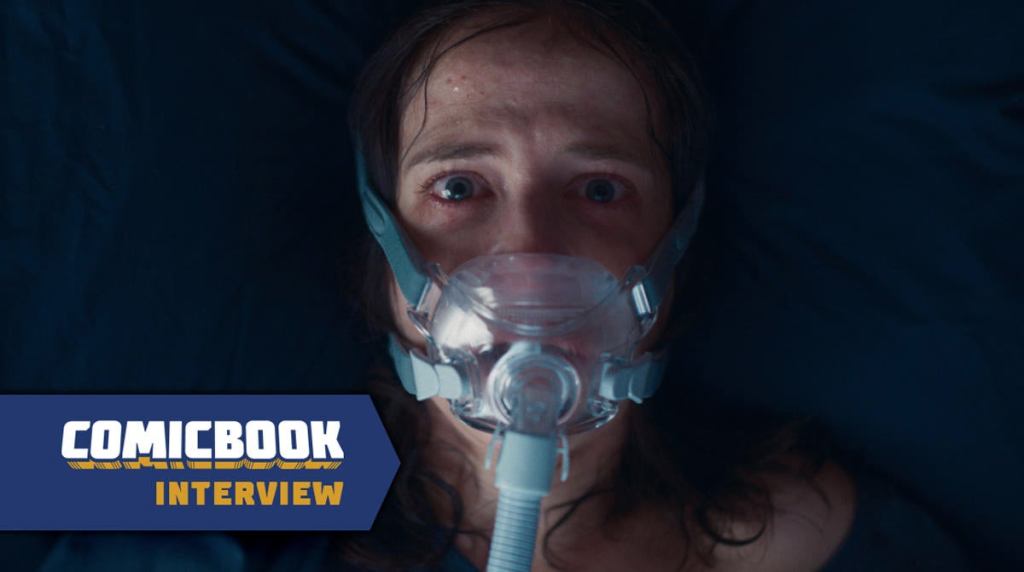With 2019’s Vivarium, director Lorcan Finnegan delivered audiences a surreal, absurdist, and confounding sci-fi story about the horrors of domestic life, which took viewers on an entirely unexpected journey that blended together a variety of cinematic tones. With his latest film, Nocebo, Finnegan delivers audiences yet another perplexing experience, yet this time delivers questions that might be even more frightening than his last effort, though also ends up offering an unsettling explanation for what the characters are enduring throughout the film’s run time. Nocebo hits theaters on November 4th and On Demand and Digital HD on November 22nd.
Videos by ComicBook.com
In Nocebo, a fashion designer (Eva Green) suffers from a mysterious illness that confounds her doctors and frustrates her husband (Mark Strong) – until help arrives in the form of a Filipino nanny (Chai Fonacier) who uses traditional folk healing to reveal a horrifying truth.
ComicBook.com caught up with Finnegan to talk his new film, its real-life inspirations, and future projects.

ComicBook.com: Going back to your previous film Vivarium, that felt like there were some real-world inspirations for why you wanted to tell that story or explore some of those themes in a slightly more heightened, elevated, genre way, so with Nocebo, was there a real-world inspiration, lightning-bolt moment of, “Oh, this is an interesting start of a journey?” Once we get a little bit towards the end of the film, there’s more real-world ramifications, but, for you, what was that initial inspiration of an idea?
Lorcan Finnegan: [Writer] Garret [Shanley] and I were basically, we read this book, we had this interest in sleep paralysis, actually. That was the first step, and read this quite academic book called Sleep Paralysis: Night-mares, Nocebos, and the Mind-Body Connection (Studies in Medical Anthropology) by Shelley Adler. It was just fascinating. It got into placebos and nocebos, and there’s a whole case study on Hmong refugees in the U.S. after the Vietnam War and how they started to die one by one from what they believed was this pressing spirit through sleep paralysis. It’s a whole other story, but it was fascinating, and it led us into the world of placebos, nocebos, and Shamanism and the connection between Shamanism and the … In Irish culture, we were Pagan before Christianity arrived, and we used Shamanism. I mean, it still does exist in certain parts of the country.
We had these powerful women who were healers, so we started looking into that more, and then we were thinking about how it works, how that exists in a contemporary world. That led us to the Philippines, where there’s still a strong tradition of folk healing and faith healing, particularly in Cebu and Siquijor.
It was a strange journey, this film, because I started to research and then did more research by going to the Philippines in 2019. Me and Garret spent quite a lot of time there talking to witch doctors, faith healers, tribal chiefs of the Ati and Badjaos tribe. Then we decided to investigate further, and we brought on these Filipino co-producers from Epic to do it as a proper Irish-Filipino co-production. We got to learn a lot about Filipino culture, but then there were also these weird connections between Irish culture and the introduction of Christianity wiping out these faith-based beliefs, colonialism arriving, and that eventually morphing into consumer culture and how all those things are connected. Those were the pieces of the story, so it wasn’t a, “Let’s make a film about this.” It was just like, “This is interesting. Oh, let’s keep going, keep digging, keep digging,” and it came about that way.
I think that answers another question I had, which is that your films seem to go in relatively unexpected directions from what an audience might read from the logline. It sounds like it’s not even necessarily a goal of yours of, “Let’s deliver a twist or a turn, because that’ll surprise audiences.” It sounds like it’s a very organic and authentic process of your research, what inspired you to take it in a completely different direction from what you initially had.
But also, the actual structure of the story was what we intended to do, to incorporate that placebo and nocebo effect onto the narrative where you can start believing one thing and that can get turned around into something else. That was the challenge with this film. It was very different to Vivarium, it was a different journey.
What’s interesting is, especially when you’re talking about some of the themes of the film, but also the tones of the film, there are times where it’s more paranoid-thriller and then other times where it’s more drama and then there are times where it’s abject horror, and there’s also some comedy in there. How much of those tonal shifts or changes are built into the script or come from the performances on set? Or do you find it all in the edit? How do you navigate that specific juggle of all those tones?
All that was in the script, really, as in the broad structure of everything and the pace and introducing these more scary elements and then coming back out into these slightly more dramatic scenes and back in again. That was all in the script, really, and then it realizes itself through performance, whether it works or not.
Certain scenes maybe become even more dramatic than you would imagine them, in a good way, or they can take on a slightly different quality once they’re performed. All of the horror elements were in the script, but I didn’t want them to … I had to dip into them and out of them rather than it suddenly just cutting to something scary and then going into a different movie. Then the lighter parts, the more funny parts, I guess they’re in Vivarium, as well. I think that’s just me and Garret like to have a little bit of fun.
Eva is so great in this, everybody’s so great, but what do you feel she brought to this role that really either made you want to give it to her, or once she was involved in the project, really took things in unexpected directions that amplified the material from what you were expecting?
Well, from the page, actually Eva and Garret and I collaborated quite a lot from the draft that she would’ve received when we were offering it to her, I mean, I thought she’d be great in the role. She’s got a very expressive face, she’s a brilliant actor. But I also wanted to get closer to her than I’d seen in other movies.
I thought her and Chai [Fonacier], as well, together made a really interesting combo. Eva has this strength and fragility to her performances. It was really just, once she came on board, she had ideas about her character, which we incorporated into the script and developed with her. Then we weren’t able to really do — we did a little bit of rehearsal, maybe two days because of COVID and where everyone was wearing masks and all that sh-t. It was really day one and Chai was really late getting into Ireland because of her quarantine and getting visas and all of that. She basically arrived on set to do the scene where she arrives at the house so she was meeting Eva on camera. Once that dynamic started over the first few days of shooting, it could really lean into it, and you could tell what was working in the dynamic between the two of them.
Your films, I wouldn’t necessarily pigeonhole them to just saying they are “horror” films, obviously they’re genre films, they’re blending together a lot of things. Fellow Irish filmmaker Lee Cronin did The Hole in the Ground and then all of a sudden he’s doing an Evil Dead movie, jumping into this major franchise. Since you are at least somewhat in that genre space, do you think there is a franchise or something that, if the right person saw one of your films, it was like, “Oh, Lorcan’s going to be great for a Nightmare on Elm Street or anything like that,” or do you think you tell personal films that you’re personally connected with and aren’t necessarily interested in a big franchise thing?
Well, it would depend. When I’ve been seeing stuff before that aren’t my own things, I just haven’t really been into them because I haven’t spent that much time with them. It’s very different when you’re working on a project for about four years, and then you go to make it. You have this intimate relationship with the work.
You never know, if I had the freedom to do something interesting with the material. But, from what I’ve heard, that isn’t really how it goes. So, now at the moment, we’re just concentrating on my own projects with Garret and with the couple of other writers, as well.
Nocebo hits theaters on November 4th and On Demand and Digital HD on November 22nd.
This interview has been edited for length and clarity. You can contact Patrick Cavanaugh directly on Twitter.








